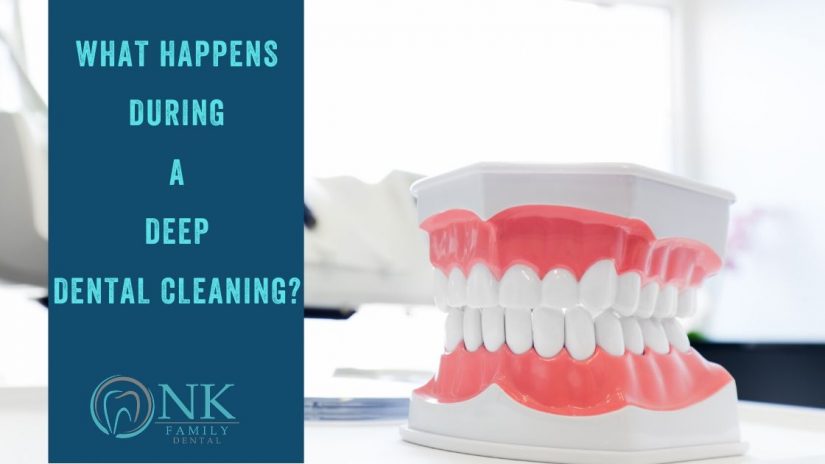
Brushing your teeth twice a day, flossing at least once, and using a mouthwash twice daily after brushing is the best day-to-day method to maintain oral hygiene between semi-annual dental checkups and cleaning. However, under certain circumstances, you may need a deep cleaning to stop the progression of early-stage periodontal disease. Let’s take a look at what a deep dental cleaning is, how to determine if a deep cleaning is needed, and how to prepare for one.
What Is a Deep Dental Cleaning?
A deep dental cleaning starts out similar to a regular cleaning. But first things first, starting with dental plaque. As Dentalcare.com explains, “Dental plaque is a sticky, colorless or pale yellow film that is constantly forming on your teeth. When saliva, food and fluids combine, plaque — which contains bacteria — forms between your teeth and along the gum line. Dental plaque begins forming on teeth 4-12 hours after brushing, which is why it is so important to brush thoroughly at least twice a day and floss daily.”
This is also why semi-annual professional cleanings are important. Even excellent oral hygiene practices at home can’t eliminate all of the plaque that turns into tartar. Unless tartar is regularly removed by a dental hygienist, it builds up, putting you at risk for — or in the initial stages of — periodontal disease. Deep cleaning is necessary when tartar buildup has caused your gums to become infected, which results in pockets — a widening of the gumline that has pulled away from the tooth (or teeth). This represents loss of connective tissue that can lead to bone loss and, eventually, tooth loss.
As the American Dental Association (ADA) describes, this deep cleaning consists of two parts: scaling and root planing. Scaling is when your dentist, dental hygienist or periodontist removes all the plaque and tartar above and below the gumline, cleaning all the way down to the bottom of the pocket. Your dental provider will then begin root planing, smoothing out your teeth roots to help your gums reattach to your teeth.
The deep cleaning process involves different tools than those used in a regular cleaning. The dental professional providing your treatment will use either manual scaling tools or electric/ultrasonic instruments to remove plaque and tartar from gum pockets and near tooth roots. Deep cleaning teeth typically requires one or two visits. The process should take around one to two hours each time, and a local anesthetic may be used to minimize potential discomfort. Scaling and root planing should not be a painful experience, however.
How to Determine If a Deep Cleaning Is Needed
So, how will you know if you need a deep cleaning? During the examination, your dental provider will use a tool called a probe, placing it beside your tooth beneath your gumline. In a healthy mouth, the pocket depth is usually between 1 and 3 millimeters (mm). Pockets deeper than 4 mm may indicate periodontitis. Your dentist may also take x-rays to see if bone loss has occurred.
Some signs you can look for in your gums and teeth that might indicate the need for a deep dental cleaning include:
- Redness
- Swelling
- Sensitivity
- Bleeding when brushing or flossing
- Teeth appearing longer (due to gum recession)
Scaling and root planing will be the first treatment step if your dental provider determines you have gum disease, or periodontitis. Other treatments will fall under the category of periodontics, which is the area of dentistry focusing on the supporting structures of the teeth, most notably the gums and mouth bones.
How to Prepare for a Deep Cleaning
Once you find out you need to have a deep dental cleaning, you’ll need to prepare. Write down your medical history before the appointment so you can communicate it with your dental provider. You’ll want to have all significant conditions or medical events ready to discuss so that your dentist can take the necessary precautions to ensure your safety.
It’s possible for the procedure to release bacteria into your bloodstream. Those who have a weakened immune system due to a heart condition, HIV/AIDS, liver disease, joint replacement or any similar medical issue will need special attention. Your dentist may prescribe an antibiotic before your appointment to reduce the risk of infection. If you take blood thinner medication, consult with your doctor to see if you can pause your dose prior to the appointment. NEVER discontinue any prescription medication for any length of time without consulting your doctor.
After the procedure, you should expect a follow-up appointment in about four to six weeks. To ensure your gum health is maintained, your dentist may also ask you to make an appointment for regular cleanings and checkups every three months instead of semi-annually — at least for a while. You may also receive further treatment from a periodontist.
Deep Dental Cleaning in Chicago
Are you looking for a dentist in the Chicago area who can perform deep dental cleanings? NK Family Dental is again open for patients. We offer both dental and periodontics services, provided by dentist Dr. Nilofer Khan and periodontist Dr. Waeil Elmisalati. Learn more about our leading dental and periodontal services in Bucktown and Logan Square, and schedule an appointment with us today! We look forward to getting your oral health back on track.
